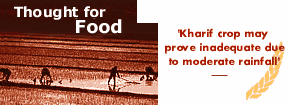

|
|
|
|
| HOME | BUSINESS | REPORT | |||
| September 9, 1999 |

Neena Haridas With just a fortnight left for the southwest monsoon to wind up in the subcontinent, a major foodgrain crisis is staring India on the face. Weathermen and the food ministry officials are still optimistic that Lord Indra (the Rain God, God of Gods and supremo of swarga -- heaven in Hindu mythology) will bail out India. However, the meteorological department has grudgingly admitted that the monsoons have not been good this year.
Earlier this year, the agriculture ministry had predicted that foodgrain production would touch a record high of 201 to 205 million tonnes, of which kharif would be a major contributor. Now, farm experts feel the country will be lucky if the kharif yield at least equals previous year's 102.6 million tonnes. The worst affected have been oilseed crops like groundnut, soyabean and coarse cereals. Although there has been marginally good rainfall in areas growing major crops such as rice, pulses and sugarcane, there is fear of shortfall here too. So what does the dry spell mean for the economy? D K Singh, a scientist at the Indian Agricultural Research Institute, says,"If the dry spell continues like this, then we could be moving towards a serious food shortage problem because harvests of major crops like rice and pulses are dwindling, not to mention the coarse cereals" Man Singh, another scientist at the IARI, predicts one of the major traps that the Indian economy is moving towards is that of falling pulses crop. Consider this: The per capita availability of pulses has fallen from 61.6 grams per kilogram in 1965 to a mere 33 grams per kilogram in 1997. Singh says this is a grave issue because pulses are the staple diet of a majority of Indians and if the yield starts dwindling, the country will face a major food security problem. Pradeep Chattopadhyay of the National Council for Applied Economic Research says, "The macro-economic repercussions can be known only in the next couple of months. But if there is a food shortage, the economy will be in jeopardy." Economists feel a shortfall of this sort could also lead to serious export-import imbalance, especially in the wake of good rabi crop this year and the brewing wheat import scandal which might hamper government decisions. At the beginning of fiscal 1999-2000, GDP growth from agriculture was placed at 5.3 per cent. A bumper rabi crop of 102 million tonnes coupled with expectations of another bumper kharif crop led many to believe that the agriculture sector’s contribution could be even higher. However, this is unlikely to happen now. According to Singh, had successive governments in India paid attention to improving the irrigation system in the country, a dry spell like this would not have spelt trouble for the economy. Despite being an agricultural country, over 50 per cent of the 14.2 million hectare cultivable land in India still depends on the monsoon for irrigation. And a failure from the skies can wreak havoc on the poor farmer. However, sources in the food ministry claim that irrigation facilities were provided well in advance in Haryana and Punjab and hence there is little to worry about. Food Minister Surjeet Singh Barnala is reportedly still optimistic that food production will top 205 million tonnes this year. Although the ministry does not see a food security problem in the near future, it will supply foodgrains at cheaper prices for the poor and weaker sections of society. The ministry has also announced the government will provide the requisite minimum support price to the farmers to maintain procurement flow in the consumer's interest. In a way, the government has taken anticipatory bail in the event of a crisis. And the government better be on its toes because if the monsoon movements are anything to go by, Barnala's hopes for a bumper crop will come a cropper. S R Kalsi, deputy director general of meteorology, Indian Meteorological Department, says, "We may finish ten per cent deficient of the aggregate average value for the country." What it means is that by the time the season ends, we will still fall ten per cent short of required rainfall -- we are already eight per cent short. Kalsi says, "Chandigarh, Delhi, Gujarat, Kerala, Marathwada, Orissa, Tamil Nadu, Uttar Pradesh are unlikely to get a major respite from the dry spell in spite of the short showers." While there is no doubt that the economy that has been inching towards a revival will switch to reverse gear if the doomsday predictions come true, social scientists are apprehensive that a bad harvest could lead to mass suicides by farmers -- a la the cotton farmers of Andhra Pradesh and Punjab.
|
| Tell us what you think of this report | |
|
HOME |
NEWS |
BUSINESS |
SPORTS |
MOVIES |
CHAT |
INFOTECH |
TRAVEL |
SINGLES BOOK SHOP | MUSIC SHOP | GIFT SHOP | HOTEL RESERVATIONS | WORLD CUP 99 EDUCATION | PERSONAL HOMEPAGES | FREE EMAIL | FEEDBACK |
|